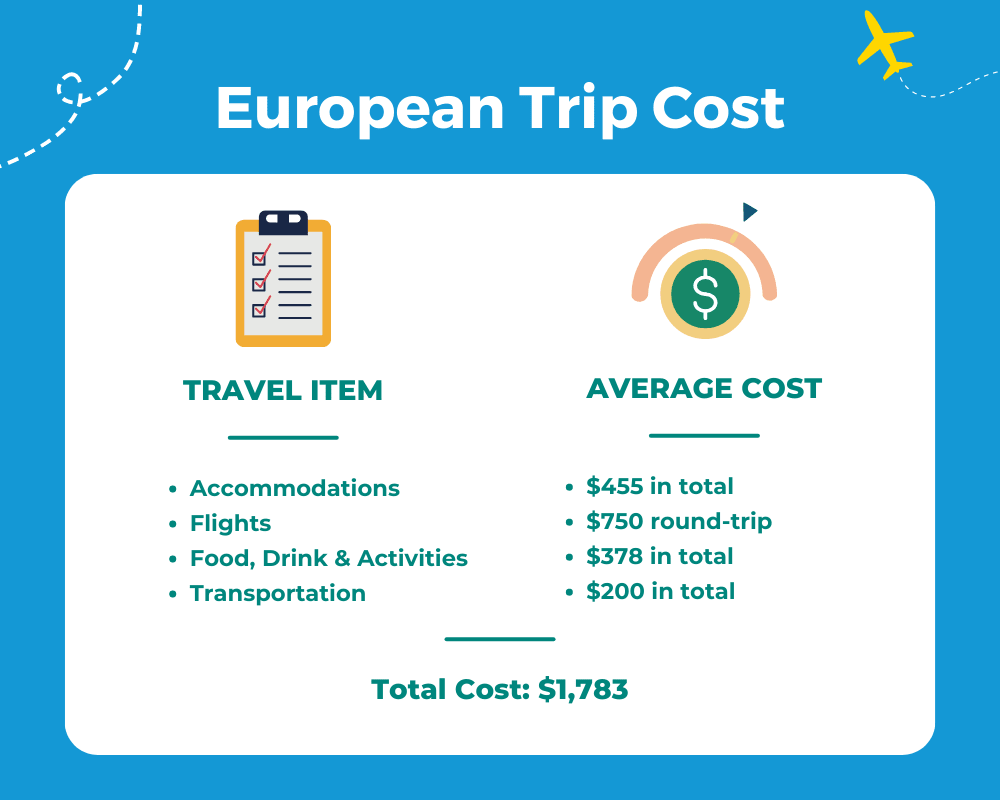What's the average trip to Europe cost?
A typical European trip for one person costs approximately $1,800 for a week, covering accommodation, flights, food, activities, and transportation. Budget-friendly options like cooking meals and exploring lesser-known cities can help you save money.
Europe is eternally appealing to most travelers due to its culture, its history, its diversity, and its sophistication. But along with all of these allures comes a price for visiting, which can vary widely depending on where you’re going and what you’ll be doing.
For example, backpacking through Bulgaria will likely set you back far less than spending two weeks in the finest hotels of Paris or Venice.
But fear not — our seasoned experts are familiar with the sights and cities of Europe and can help you to separate its bargain destinations from its overpriced tourist traps.
We can also tell you how to travel through Europe on a budget, including how and when to book cheap flights and hotels and where to be wined and dined that won’t cost a fortune. Read on to see what Europe has in store for you!
Average Trip to Europe Cost in 2024

An average seven-day vacation in Europe costs close to $1,800. This can be broken down as follows:
- Average Accommodation Cost: $455
- Average Flight Cost: $750
- Food, Drinks & Activities: $378
- Transportation: $200
- Total Cost: $1,783
Of course, these figures are more slanted toward tours of Western Europe than those foraying into Eastern Europe, which can be considerably cheaper.
One helpful way to think about Europe is to imagine all of the countries being like U.S. states in both size and proximity to one another.
In fact, believe it or not, there are more countries in Europe (51) than there are U.S. states (50), if you count the very tiny European nations like Liechtenstein, Luxembourg, Andorra, and San Marino.
Because all the European nations are relatively close to one another, flights between the different countries are usually very short and can be shockingly inexpensive (tales of $30-or-less flights abound).
Another way to get from one place to another in Europe is the train, which — depending on where you’re going — can be both faster and much more pleasant than a journey by airplane.
European Trip Cost: Average by Item

SCStock/Shutterstock
Accommodation Costs
As with the other items in the list above, accommodation costs can vary widely depending on what level of quality you aim for and where you’re staying. Even the worst accommodation in Gstaad, Switzerland, may cost far beyond what the best room in Tirana (the capital of Albania) will set you back.
Bear in mind that, beyond paying a premium for more in-demand cities (Paris, Rome, London, Amsterdam, Venice), the style and exact location of the accommodation will have a lot to do with the price.
(Is the room in a modern new hotel in the center of town, or is it in an older inn on the outskirts of the city?) Extra options like swimming pools, room service, and in-house dining options will bump up prices, as will views and proximity to tourist attractions.
Although hotels that belong to chains (especially American-based ones) may have a familiar look and feel, by European standards, these tend to be fairly bland and generic.
But worry not — the European hotels that have the most authentic style and flair are definitely those that don’t belong to chains (but don’t worry; most of their staff speak English, and you shouldn’t have any trouble communicating).
Of course, no one says you have to stay in a fancy hotel, particularly if you’re budget-conscious. These days, VRBO or other vacation rental/home-stay options can be both inexpensive and more creative and flexible for both individual travelers and families.
Below is a table of 15 of the top destinations in Europe with the average cost of accommodation per night in both a hotel and a vacation rental for each location.
| City | Average Hotel Cost/Night | Average Vacation Rental Cost/Night |
|---|---|---|
| Paris | $180 | $159 |
| Barcelona | $120 | $140 |
| Rome | $99 | $128 |
| London | $147 | $124 |
| Amsterdam | $127 | $155 |
| Prague | $116 | $95 |
| Berlin | $113 | $73 |
| Athens | $65 | $73 |
| Florence | $124 | $140 |
| Vienna | $153 | $80 |
| Lisbon | $114 | $59 |
| Dublin | $137 | $143 |
| Budapest | $65 | $73 |
| Istanbul | $84 | $75 |
| Stockholm | $88 | $85 |
As you can see, hotels in these cities may be cheaper on average than vacation home rentals — but not always. Another popular option for travelers to Europe is youth hostels, which — as the name indicates — are really aimed at young people.
Many of these lodging options don’t have hard limits on the ages of guests, although you should know ahead of time that many travelers in these places tend to be under the age of 25!
For those on a real budget, there still exists in places something of a culture for backpackers.
Of course, you don’t see as many of these souls as one might have in, say, the 1970s, but by consulting a few guides dedicated to this activity, you may quickly find out which cities, routes, and accommodations are “backpacker-friendly.”
Flight Costs
As hinted above, flights within Europe can be an order of magnitude cheaper than transcontinental flights to Europe from the United States.
Of course, the number of stops, the day you travel, and the day you return will all impact the price of flights, as will the number of weeks or months in advance you book (see below). One popular option for getting cheaper flights is to stop over in Iceland.
Icelandair offers this option, which can lower the price of a round-trip ticket. For instance, a direct flight from New York to Paris might cost $600, but an Icelandair flight that stops over in Reykjavík may only cost $450.
Another option to consider is to fly into a less popular airport or even city in the country you’re traveling to.
For instance, a flight to Paris’ Charles de Gaulle (CDG) airport may be more expensive than one that flies into the city’s Orly (ORY) airport.
Or, consider flying to a cheaper destination entirely (Frankfurt, anyone?) and taking one of the cheap intra-European airlines (such as Easyjet or RyanAir) to get to your intended destination. Yes, this might take longer and be a bit more of a hassle, but the savings could well be worthwhile.
Food, Drink & Activity Costs
As with dining at home, the easiest way to save on food costs is to cook for yourself, but if you’re staying in a hotel versus at a vacation home rental property, this may be impossible.
Still, if you do have access to a kitchen, you shouldn’t be daunted by European supermarkets. As long as you’re able to use European money, you should be OK. Just remember the one thing most Europeans do when they go to the supermarket — they bring their own bag. This not only saves money, but it’s also good for the environment.
But don’t worry if you forget a bag; most markets will let you buy one for about 25 cents. One of the best parts of European supermarkets is all the foods you won’t see at home — you’ll likely be amazed at what you’ll find!
If you do eat out, any restaurant with table service will generally cost more than one without it. Also, before sitting down, note how many locals versus tourists are eating there.
Very often, a restaurant with more tourist customers than locals will cost more, and the food won’t be as good as some favorite spots for locals. In terms of drinks, you should be able to find refreshing beverages almost anywhere, and prices should be reasonable.
The bottles and cans, as well as the beverages they contain, may be different from what you’re used to back home, but in many cases, they’re better made and less expensive (for instance, in Germany, many of the locally brewed beers that are available are cheaper than bottled water)!
Numerous European cities are famous for a few key attractions.
For instance, people might say it’s sacrilege to visit Paris without going up to the top of the Eiffel Tower, but these key attractions can be incredibly pricey and have hours-long lines that may make the wait more memorable (and not in a good way) than the destination.
Instead of following a crowd to a few “must-see” tourist attractions, you might consider stepping off the beaten path and just trying to enjoy the everyday scenery of European cities.
Very often, you’ll come across fascinating locations, markets, and squares that aren’t necessarily on tourist maps but have a character and a style that are all their own.
The places and buildings that give a city the feeling and life it has are sometimes the most ordinary of structures — churches, train stations, city halls, or public baths. It doesn’t hurt to ask a local person what they think is a fascinating or worthwhile place to visit.
Such a place may be quite different from what’s in your guidebook. The worst thing they might say is that they don’t understand you — but you’d be surprised at how many people in Europe actually speak English
Transportation Costs
Transportation costs in Europe will vary widely depending on where you travel, but in most urban centers, the public transit systems are better run than the systems of the U.S., meaning that they go to more places, are better maintained, and may operate more frequently.
Renting a car isn’t difficult if you’ve got both a passport and a valid American driver’s license, but some European countries also require an International Driver’s Permit (IDP), which is a sort of alternate form of identification and can be had for about $20 from driving organization AAA.
On the other hand, taxis can be incredibly expensive — a 100-Euro ride across some of the larger cities — particularly in heavy traffic — may not be unheard of.
If you don’t know the route from where you get in a taxi to your destination, you may want to see it on a screen or a smartphone before you go too far.
In fact, it may be wiser to use public transit when you’re able to — or even walk. Yes, walk! After all, in many cases, the streets are less crowded, more scenic, cleaner, and safer than their American counterparts.
Another option is renting a bicycle, but remember that — at least in the UK, where all the vehicles drive on the “wrong side” of the road — steering a bicycle may mean putting yourself into traffic that drives faster and more dangerously than you’re used to.
Also, be aware that bicycle theft in Europe is at least as common as it is in many cities in the U.S.
Things to Consider

Catarina Belova/Shutterstock
Probably the most important element to consider when planning a European vacation is when to book your flights, hotels, etc.
In many respects, there’s no such thing as too far in advance, although it’s always possible that booking prices could fall as opposed to rise. But they’re much more likely to do the latter, especially if you wait too long.
At the very least, it’s recommended that you book your trip a minimum of three months (90 days) in advance, but more ideally, six months in advance or more if you desire to travel during the summer (high season).
This can mean booking by Christmas at the latest if you want to travel the following June. The longer you wait and the less time that remains, the greater the chances that the flight, accommodations, and other options will be sold out by the time you choose to book.
Or, don’t be surprised if you do wait that the only options left by the time you try to make reservations are a red-eye flight and/or a room at a Holiday Inn in a remote part of town. Don’t say you weren’t warned!
Another common question that comes up about Europe is when and how much to tip. It’s a myth that people don’t tip in Europe. Just as in the States, many servers rely virtually solely on tips for their income.
Europeans do tip! But in some cases, the amount of the tip may be less than what someone might tip in, say, New York City. But also bear in mind that many Americans are better off financially than European citizens.
If a service is good, and you can afford to tip, you should do so, and don’t be afraid to leave as much or almost as much as you might in the States. It will be appreciated.
Read Next: The Very Best Time to Visit Europe in 2024
Additional Considerations
If you’re going to Europe, there are a few additional considerations you should take into account:
Most people dress a bit differently than they do in the U.S. They’re not as casual or nonchalant about what they wear. They don’t wear pajamas to the supermarket or to a big-box store, for example. Almost no one wears a baseball cap, UGG boots, or a fanny pack.
The wearing of sports-related merchandise is usually limited to game-day attendees of local sports matches. It’s uncommon for people to wear t-shirts or sweatshirts emblazoned with the logos of colleges, beer brands, tourist destinations, or TV shows.
This is not to say that you can’t wear what you want when you want to wear it, but many people who wear those items will be looked upon as having little taste.
Be aware of pickpockets and other criminals who target tourists especially. Many of these unscrupulous characters work in gangs and use different techniques to distract you while their partners steal your money or your belongings.
Many of them can be found close to large hotels and tourist sites. If you dress like an average American (see above), you may be targeted for their scams.
If you have doubts about one of these people’s legitimacy, ask to see their license or their identification. Don’t get too close to them, keep your wallet and belongings securely on your person, and don’t get distracted.
Don’t be shy to walk around in a smaller group or solo, as large, loud groups are often shied away from or frowned upon by locals. You’ll cover more ground walking in a small group or alone, and you may be received in a friendlier manner by strangers and business proprietors.
Europeans are generally civilized and kind-hearted people. They don’t take kindly to rude, arrogant, aggressive, or self-centered behavior.
Although many people do speak English, they’ll greatly appreciate it if you learn how to at least say “please,” “sorry,” “excuse me,” and “thank you” in their language. It often pays dividends to be interested in their language, habits, and culture.
Take the time to do a little research before your trip and read up on some local history; you may well acquire some valuable, interesting, and insightful knowledge!
In general, don’t be afraid to travel around Europe, but beware of tours that take you to “10 cities in 10 days,” as you usually won’t get a feel for a city or a country if you’re only there for a short period, and you may become exhausted if most of your time is spent traveling.
Consider visiting not the common tourist destinations of Paris, Rome, London, Barcelona, Venice, or Amsterdam.
Instead, try going to some of the lesser-known cities, like Brussels, Berlin, Prague, Naples, Marseilles, Lisbon, or Hamburg. These places have just as much to offer as the better-known places and will likely be cheaper, too.
Frequently Asked Questions

Umomos/Shutterstock
What’s the most beautiful European country to visit?
There’s no correct answer to this question, but Italy ranks high on the list due to its natural scenery and varying geography. France, Spain, Greece, and Switzerland are also high on this list.
What’s the best time of year to visit Europe?
The obvious answer here is the summer, but remember that this is the high tourist season, and prices may be at their peak (August should generally be avoided as many Europeans go on vacation themselves then). The spring and fall may be better bets than the summer, and Southern Europe is usually nice to visit year-round.
Where should you change your money, and where will you get the best exchange rate?
All things considered, it may be smartest to exchange your money for Euro notes at your home bank before you leave. Banks will often have the most reasonable exchange rates. Remember that some countries (such as Switzerland and the Czech Republic) don’t use the Euro.
Beware of using ATMs in Europe, as these are sometimes hard to find and often have shockingly high fees. The number of stores and restaurants that accept credit cards is fewer than in the U.S., so it pays to keep cash on hand when you can, but be sure to keep it secure and don’t be flashy with it.
Is Europe safe for travelers?
Most of Europe is much safer than the United States in terms of common crime, but use your head and street smarts, and try not to stand out as a tourist if you can.
What should you bring with you on a trip to Europe?
Generally speaking, consider not taking anything too valuable or too many clothes. You’ll likely see many things you’ll want to buy, and you’ll need to have a place to put them!
So, What Does the Average European Trip Cost?
| 🛎️ Average Accommodation Cost | $455 in total |
| ✈️ Average Flight Cost | $750 round-trip |
| 🍽️ Food, Drink & Activities | $378 in total |
| 🚕 Transportation | $200 in total |
| 💲 Total Cost | $1,783 |
Again, your costs can vary widely depending on what places you go and where you stay.
But, generally speaking, staying away from the common, obvious tourist destinations (both the cities themselves and their attractions within) will save you money and usually lead to a more interesting experience.
It’s hard to go wrong if you budget $200 per day overall and don’t stay in a fancy hotel. But even on a shoestring budget, you’d be surprised at what’s possible.
Thinking (and acting) like a local instead of a visitor will often reward you with savings, discounts, and freebies. It pays to do some research on the web ahead of time and/or pick up a guidebook before you go. Happy travels!



